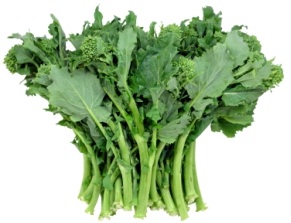Eating Greens is a Special Treat
Eating Greens is a Special Treat
By Carmelo Sigona
“Eating greens is a special treat” may seem more appropriate for Bambi’s buddy Thumper the rabbit to say rather than a human, but eating local greens really is a special treat!
Of course, there’s more to greens than lettuces and spinach. We like it when customers start thinking outside they typical-greens box and ask us for information about choices such as broccoli rabe, Lacinato kale and curly mustard greens.
Following is a little info on each of the three mentioned above. They’re all packed with nutrients and flavor and are versatile enough to quench any culinary curiosity. Which is your favorite?
“Blue” Lacinato Kale
Also known as dinosaur kale, black kale or Tuscan kale, Lacinato kale is another of my favorite greens. It’s very versatile and makes for hearty, tasty and…wait for it…easy dishes.
Lacinato kale has dark greenish-blue leaves with bumpy texture makes it easily identifiable compared to other smoother kale varieties. The leaves of Lacinato kale are easy to strip from the thick, white stalks and their cabbage-like earthy flavor is great in soups or even raw in salads. Kale, as with all dark, leafy greens, is packed with nutrients, phytonutrients and vitamins, such as vitamins K, C and A, which can help maintain healthy teeth and bones. Sicilians and Italians alike are particularly fond of this variety of kale – you’ll often see it featured in recipes along with cannellini beans and ham – a classic Italian comfort dish.
Some say Lacinato kale must be cooked before used in dishes, but I don’t agree. Raw kale salads are becoming more common these days as the green adds a distinct, rich, bitter bite that can’t be acquired with just any regular lettuce or other leafy green. They work well when the leaves are chiffonade into thin, delicate treats.
Kale stems tend to be a bit tough and are typically removed prior to eating or cooking. However, if the stems are thin and tender, you can simply trim off the lower portion cook them with the leaves, if preparing a stew or another cooked dish.
Broccoli Rabe
When it comes to broccoli rabe, also known as Rapini or broccoli raab, get ready for a pungent taste. One resource even describes the pungency as an “assertive wallop.” Broccoli rabe is the king of bitter greens, and, as such, is a much sought-after green that’s popular among Sicilians, Italians and Chinese. It’s in these cultures that a bitter punch is a high ranking palate pleaser.
Don’t let the broccoli part of this green’s name fool you; this veggie is more related to a turnip than regular broccoli. In Italian, the word “broccoli” means little sprouts, and in Italy the word is used to describe things such as sprouts on cabbages or cauliflower that have gone to seed in the field.
There are tons of ways to fix this green. When I bring home a few bunches, I remove about an inch of the lower stems, blanch them in boiling water for 2-3 minutes, drain and then quickly get them in an ice bath. After they’ve cooled, I drain them well, pat them dry with a cloth towel and store in the fridge to use for quick, easy meals during the week. For those who have not developed a taste for bitter greens, remember this tip: blanching first takes some of the bitterness out. Also partnering with less potent ingredients, such as pasta or polenta or even a mild, white fish, could make these greens a favorite.
For a quick veggie I just sauté the pre-prepped broccoli rabe with olive oil, garlic and red pepper flakes. They’re more tough than the leaves, but are juicy and tender when sautéed longer than the leaves. Broccoli rabe leaves cook quickly so be careful not to overcook.
I’ll then mix the sauté with a disproportionately small amount of brown rice pasta (my preference) or whole wheat pasta (stir in a bit of the pasta water so it’s not too dry). Don’t forget to grate a fresh Parmigiano Reggiano cheese on top, if you so wish.
Curly Mustard
Most mustard greens have a slight bitter taste…. that’s one of the attractions for those who love bitter greens, but could do without the “assertive wallop.”
Curly mustard greens have a firmer texture and different flavor… when fresh picked they have a slight bitter/sweet flavor. There are two common types of mustard greens, the curly and the Chinese mustard, or flat leaf. The curly, as its name indicates, has a frilly edge and is more popular by Italians, Sicilians and in the South. The Chinese mustard has a flat leaf and is more commonly cooked, steamed or used in stir-fries.
The wild mustard is by far my favorite…well, it’s a Sicilian favorite. At least in my family. It’s no surprise they’re a treat in my family; my mother and her mother learned to cook in Louisiana after emigrating from Sicily.
When my brothers and sister and I were children, my father would head out in the early spring to seek out these plentiful gems – he’d return with sacks full! They still grow out in the wild and you can find them growing just about anywhere if you look closely. My father always had luck in the hills of John Mclaren park in San Francisco.
This green does take some time to strip from its lower stem, but must be done before eating as the stem is a bit tough. The leaves, upper tender stems and little flowers on top are the edible parts.
Serving options are endless…oh let me count the ways! Typically, in households using wild mustard greens, you’ll find them literally served by the platter. Mustard greens are best served simply: blanched, and sautéed with EVOO and garlic. As an option, you can toss with a little pasta.
A Special Treat for the Body
Overall, greens are so low in calories per cup and are packed with vitamins and nutrients such as Vitamins A, C and K as well as potassium and iron. Another benefit, beta-carotene, helps improve immune-system functions, folic acid, calcium and magnesium, which support bone health.
A general rule thumb noted in most nutrition posts and healthy cookbooks is that the darker the green, the more loaded it is with nutritional benefits, so be sure to check out our recipes for Lacinato kale, broccoli rabe and curly mustard greens.












